Id like to thank the many friends who have shared their knowledge of Yellowstone Park waters.
A special thank you goes to Todd Koel, senior fisheries biologist; Patricia Bigelow; Brian Ertel, fisheries restoration biologist; and their crews with the Yellowstone Center for Resources for sharing their incredible knowledge of Yellowstone Parks waters and its fishery, as well as their hard work protecting, preserving, and enhancing park waters and their native and wild fish so that all future generations can enjoy them as they have for over 150 years. I would also like to thank my good friends John Juracek and Patrick Daigle, who contributed photographs that add greatly to this book. A special thanks to Howard Back, Ray Bergman, Charlie Brooks, and Nick Lyons, whose narratives inspired me to make Yellowstone waters my home waters. And, without the help and encouragement of editor Eugene Brissie of Globe Pequot/Lyons Press, this book would not have been possible. Thank you, Gene.
This section contains four of the parks most popular rivers: the Madison, Gallatin, Gardner, and Gibbon. All are easily accessible by car and rated as blue-ribbon trout streams. The US Fish and Wildlife Service rates the Madison River as the worlds second-best trout stream; it rates the Yellowstone River number one.
Gallatin River rainbow trout
In The Living River, Charles Brooks describes the Madison River as the worlds largest chalk stream. He wrote that its waters are rich in calcium bicarbonate, the mineral most critical to aquatic life and the base of the food chain that nourishes the wild trout this river is world famous for.
The Shoshone called the Gallatin River Cut-tuh-o-gwa, or swift river. The Gallatin is this and much more. Its icy waters hold a diverse and abundant insect population, providing plenty of food for mountain whitefish and four species of trout.
The Gardner River is often overlooked in favor of more publicized waters. Locals like it that way, and keep it under their hats. The river offers something for every angler: meadow water for the dry-fly angler and rough-and-tumble stretches for the nymph and streamer anglers. Attractor flies and terrestrials provide great fishing all summer long.
The secrets of the Gibbon River are under lock, and only the patient and observant angler will learn the combination. Undercuts and deep pools hold huge trout and the rare grayling. Riffles, runs, and pockets hide rainbows and brook trout. The Gibbon gives fly-fishers the choice of an easy or challenging day.
Good fishing is where you find it, and numerous small streams, lakes, and ponds in the northwestern section of Yellowstone offer great angling for those willing to explore the backcountry.
Map 1 Madison River
Map 2 Gallatin River
Map 3 Gardner River
Map 4 Gibbon River
Arrow Canyon Creek (Map 3)
BROOK TROUT
 This small tributary to the headwaters of Lava Creek can be reached by following Lava Creek upstream for 8 miles from the Lava Creek picnic area. The fishing is fair for small brook trout that average 6 inches. There is no trail along the creek.
This small tributary to the headwaters of Lava Creek can be reached by following Lava Creek upstream for 8 miles from the Lava Creek picnic area. The fishing is fair for small brook trout that average 6 inches. There is no trail along the creek.
Bacon Rind Creek (Map 2)
CUTTHROAT RAINBOW TROUT BROWN TROUT
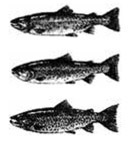 This small, icy tributary to the upper Gallatin River is between mile markers 22 and 23 north on Highway 191 from West Yellowstone, Montana. A good trail follows the creek up the valley and avoids downfall and brushy areas along the way. The best fishing is in the pools, pockets, and along undercuts between riffles. Cutthroat, brown, and rainbow trout averaging 9 inches attack most small terrestrial and attractor dry fly patterns. The stream clears of snowmelt in mid-June and is very popular with visiting anglers who want to catch a cutthroat trout.
This small, icy tributary to the upper Gallatin River is between mile markers 22 and 23 north on Highway 191 from West Yellowstone, Montana. A good trail follows the creek up the valley and avoids downfall and brushy areas along the way. The best fishing is in the pools, pockets, and along undercuts between riffles. Cutthroat, brown, and rainbow trout averaging 9 inches attack most small terrestrial and attractor dry fly patterns. The stream clears of snowmelt in mid-June and is very popular with visiting anglers who want to catch a cutthroat trout.
Black Butte Creek (Map 2)
A tiny tributary to the Gallatin, entering the river at the Black Butte trailhead. It does not hold a fishable population of trout.
Blacktail Deer Creek (Map 3)
BROOK TROUT CUTTHROAT
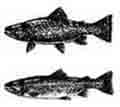 This lovely tributary to the Yellowstone River is 7 miles east of Mammoth on the Mammoth-Tower Highway. Blacktail Deer Trail follows the creek along the 4-mile stretch downstream to the river. Along the way it is excellent fishing for richly colored 9- to 11-inch brook trout. A short section of the creek upstream of the junction can hold Yellowstone cutthroat trout up to 17 inches long that run upstream to escape heavy runoff flows or to take advantage of grasshoppers or crickets in late summer. During terrestrial time, July through October, the trout ravenously attack flying ant, grasshopper, cricket, and long-horned beetle imitations. Easy access and great fishing make this gem one of Yellowstones most popular small streams. The fishing upstream of the highway can be a sleeper, because it receives less fishing pressure, but its closed to human access until June 30 per bear management regulations.
This lovely tributary to the Yellowstone River is 7 miles east of Mammoth on the Mammoth-Tower Highway. Blacktail Deer Trail follows the creek along the 4-mile stretch downstream to the river. Along the way it is excellent fishing for richly colored 9- to 11-inch brook trout. A short section of the creek upstream of the junction can hold Yellowstone cutthroat trout up to 17 inches long that run upstream to escape heavy runoff flows or to take advantage of grasshoppers or crickets in late summer. During terrestrial time, July through October, the trout ravenously attack flying ant, grasshopper, cricket, and long-horned beetle imitations. Easy access and great fishing make this gem one of Yellowstones most popular small streams. The fishing upstream of the highway can be a sleeper, because it receives less fishing pressure, but its closed to human access until June 30 per bear management regulations.
Blacktail Deer Creek brook trout
Campanula Creek (Map 1)
BROOK TROUT
 This small tributary to Duck Creek lies within a bear management area in Yellowstone Park. It enters Duck Creek from the north, a mile east of the Gneiss Creek trailhead. It contains brook trout. Before bear-human conflict issues, the beaver ponds on the creek held big brook trout, but the creek and its ponds are currently, and rightfully, closed to humans March 1 through September 30 for bear management.
This small tributary to Duck Creek lies within a bear management area in Yellowstone Park. It enters Duck Creek from the north, a mile east of the Gneiss Creek trailhead. It contains brook trout. Before bear-human conflict issues, the beaver ponds on the creek held big brook trout, but the creek and its ponds are currently, and rightfully, closed to humans March 1 through September 30 for bear management.


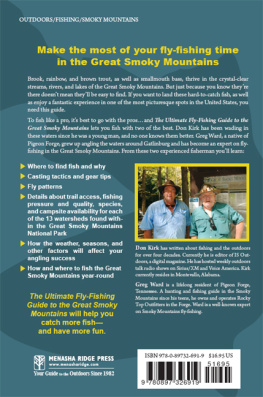
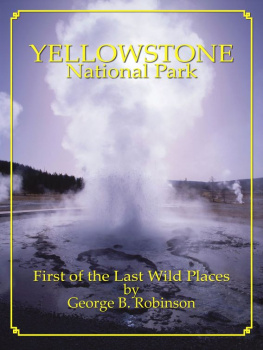
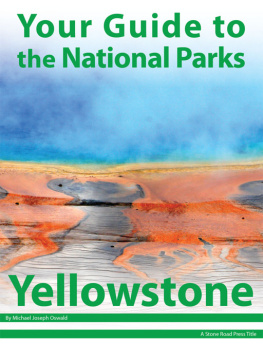
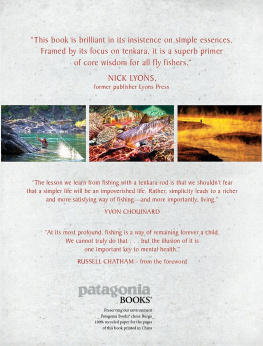



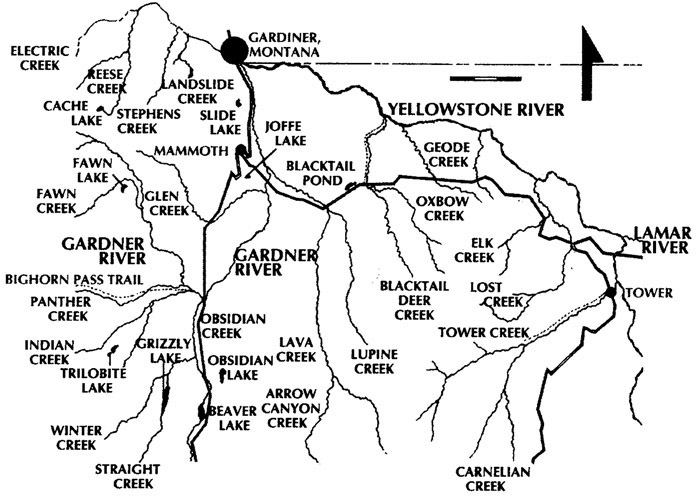
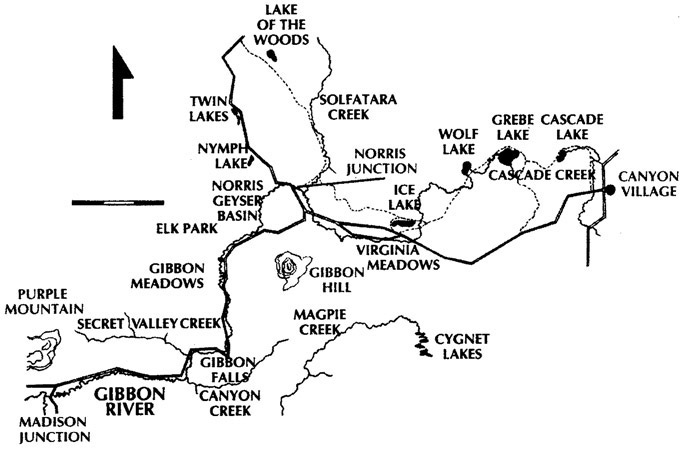

 This small tributary to the headwaters of Lava Creek can be reached by following Lava Creek upstream for 8 miles from the Lava Creek picnic area. The fishing is fair for small brook trout that average 6 inches. There is no trail along the creek.
This small tributary to the headwaters of Lava Creek can be reached by following Lava Creek upstream for 8 miles from the Lava Creek picnic area. The fishing is fair for small brook trout that average 6 inches. There is no trail along the creek.
 This small, icy tributary to the upper Gallatin River is between mile markers 22 and 23 north on Highway 191 from West Yellowstone, Montana. A good trail follows the creek up the valley and avoids downfall and brushy areas along the way. The best fishing is in the pools, pockets, and along undercuts between riffles. Cutthroat, brown, and rainbow trout averaging 9 inches attack most small terrestrial and attractor dry fly patterns. The stream clears of snowmelt in mid-June and is very popular with visiting anglers who want to catch a cutthroat trout.
This small, icy tributary to the upper Gallatin River is between mile markers 22 and 23 north on Highway 191 from West Yellowstone, Montana. A good trail follows the creek up the valley and avoids downfall and brushy areas along the way. The best fishing is in the pools, pockets, and along undercuts between riffles. Cutthroat, brown, and rainbow trout averaging 9 inches attack most small terrestrial and attractor dry fly patterns. The stream clears of snowmelt in mid-June and is very popular with visiting anglers who want to catch a cutthroat trout.

 This lovely tributary to the Yellowstone River is 7 miles east of Mammoth on the Mammoth-Tower Highway. Blacktail Deer Trail follows the creek along the 4-mile stretch downstream to the river. Along the way it is excellent fishing for richly colored 9- to 11-inch brook trout. A short section of the creek upstream of the junction can hold Yellowstone cutthroat trout up to 17 inches long that run upstream to escape heavy runoff flows or to take advantage of grasshoppers or crickets in late summer. During terrestrial time, July through October, the trout ravenously attack flying ant, grasshopper, cricket, and long-horned beetle imitations. Easy access and great fishing make this gem one of Yellowstones most popular small streams. The fishing upstream of the highway can be a sleeper, because it receives less fishing pressure, but its closed to human access until June 30 per bear management regulations.
This lovely tributary to the Yellowstone River is 7 miles east of Mammoth on the Mammoth-Tower Highway. Blacktail Deer Trail follows the creek along the 4-mile stretch downstream to the river. Along the way it is excellent fishing for richly colored 9- to 11-inch brook trout. A short section of the creek upstream of the junction can hold Yellowstone cutthroat trout up to 17 inches long that run upstream to escape heavy runoff flows or to take advantage of grasshoppers or crickets in late summer. During terrestrial time, July through October, the trout ravenously attack flying ant, grasshopper, cricket, and long-horned beetle imitations. Easy access and great fishing make this gem one of Yellowstones most popular small streams. The fishing upstream of the highway can be a sleeper, because it receives less fishing pressure, but its closed to human access until June 30 per bear management regulations.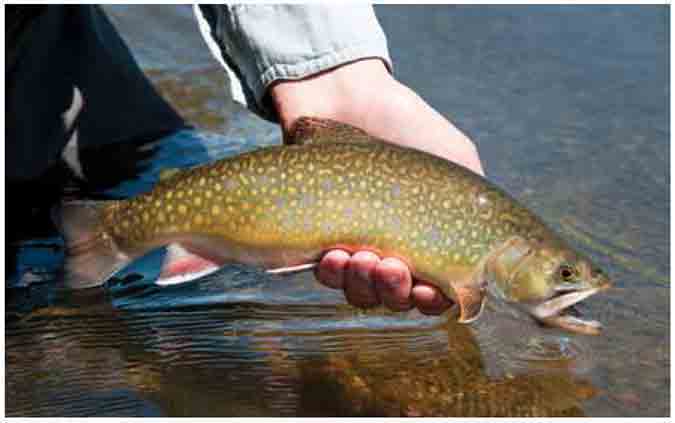

 This small tributary to Duck Creek lies within a bear management area in Yellowstone Park. It enters Duck Creek from the north, a mile east of the Gneiss Creek trailhead. It contains brook trout. Before bear-human conflict issues, the beaver ponds on the creek held big brook trout, but the creek and its ponds are currently, and rightfully, closed to humans March 1 through September 30 for bear management.
This small tributary to Duck Creek lies within a bear management area in Yellowstone Park. It enters Duck Creek from the north, a mile east of the Gneiss Creek trailhead. It contains brook trout. Before bear-human conflict issues, the beaver ponds on the creek held big brook trout, but the creek and its ponds are currently, and rightfully, closed to humans March 1 through September 30 for bear management.